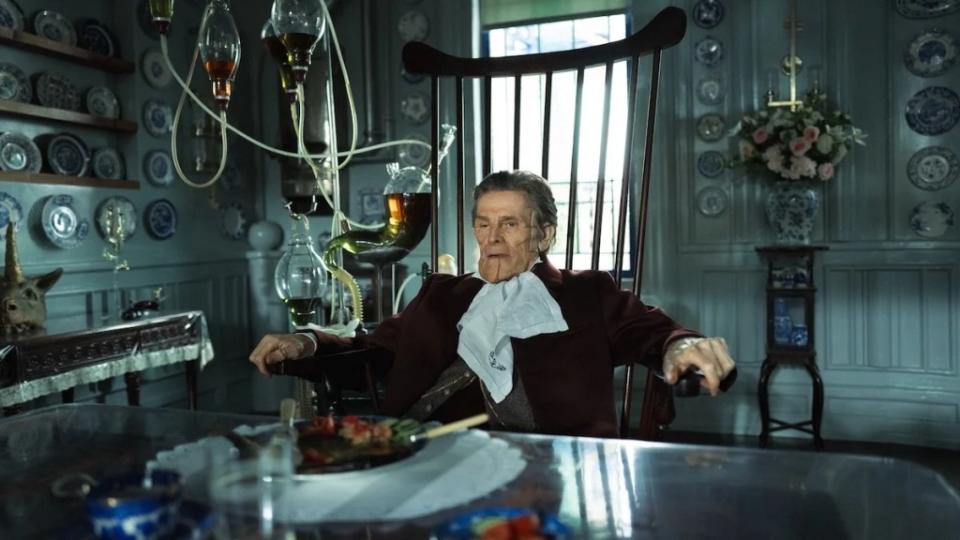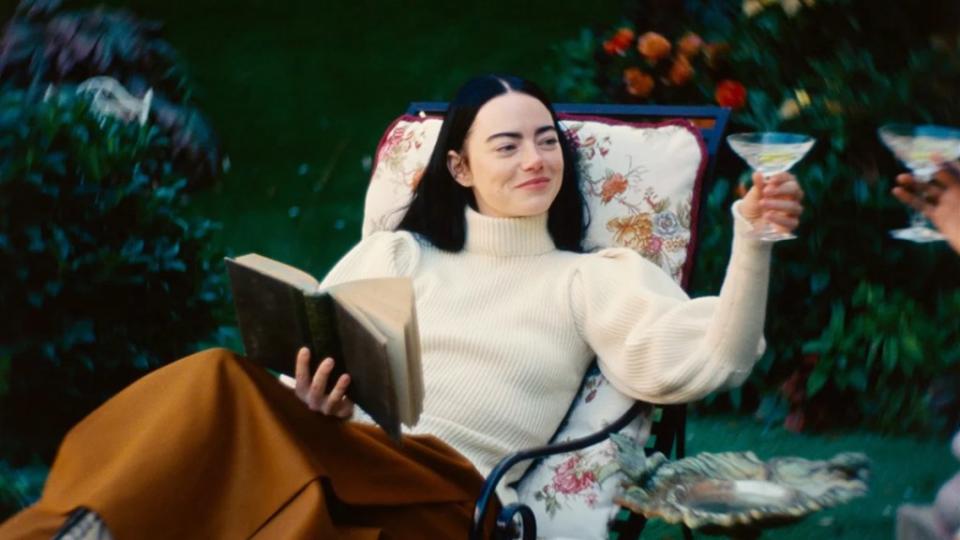Inside the ‘Poor Things’ World of Miniature Steamships, Massive Sets and Sleeves That Look Like Lungs
- Oops!Something went wrong.Please try again later.
- Oops!Something went wrong.Please try again later.
- Oops!Something went wrong.Please try again later.
- Oops!Something went wrong.Please try again later.
- Oops!Something went wrong.Please try again later.
In movie history, there are a rare few directors whose style has coined an adjective: Felliniesque, Hitchcockian, Chaplinesque. The modern filmmaker most likely to join that class is Yorgos Lanthimos, the Greek auteur famed for “The Lobster” and “The Favourite,” whose newest, wildest project, “Poor Things,” is his most colorful and phantasmagorical to date.
The look of the film – set in a fairy tale 19th century world unlike any you’ve ever seen – is singular, even if the moniker Lanthimosian doesn’t quite roll off the tongue.
“That’s a really hard word to say,” said cinematographer Robbie Ryan with a laugh. The Irish camera maestro earned an Oscar nomination for “The Favourite,” his previous collaboration with Lanthimos.
“Maybe Lanthimosesque is better – or is it even worse? I do totally agree, though: His filmmaking is signature, for sure. It’s inventive in a way that’s undefinable. I can describe his style by saying that I never know what Yorgos is going to do next. He is practical and pragmatic but he is also very enigmatic.”
And no doubt that last characteristic drew Lanthimos to the late Scottish author Alasdair Gray’s 1992 novel “Poor Things,” an allegorical and fantastical narrative that can be interpreted from several societal angles at once. In the book and film, the plot follows Victorian era heroine Bella Baxter (Emma Stone), the childlike medical invention of a Frankenstein figure (Willem Dafoe), as she embarks on an adventure of self-discovery.
Her journey, which begins in London and at one point involves an ocean liner, includes stops in Paris, Lisbon and Alexandria. These cities, with grand town squares, decadent apartments, narrow streets, restaurants, dining halls and beautiful promenades, were constructed from scratch in Budapest on some of the largest soundstages in all of Europe. The sets required months to build, with each butting up against the walls and ceilings of the stage.
“Incredibly, the doors on the set didn’t go into voids,” said James Price (“Paddington 2” and this year’s “The Iron Claw”), who helped conjure up the elaborate production alongside Shona Heath. “Everything we designed had something behind it, whether it was the end of a street or through the window or in the sky or the ceiling. Everything led to something else and it kept on getting bigger and bigger. At one time, we reckoned that we had three-quarters of all construction crews in Hungary working on the film.”
Heath, whose background includes sumptuous art direction in the fashion industry, estimated that 95% of “Poor Things” was filmed on soundstages. “One of the scenes we shot in a real forest, which felt like a bit of a compromise at the time,” she said. “But we gave the forest a ‘Poor Things’ makeover by installing a
giant tree at a crazy 45-degree angle. And when I watch the scene, I love the fact that it seems so open and real, except for this very huge tree.”
Perfect realism, of course, was not Lanthimos’s top priority, though he still insisted on verisimilitude – the real within the fake – in every scene. The director showed his production designers movies such as 1967’s “Belle de Jour” by Luis Buñuel, Conrad Veidt’s 1924 silent classic “The Thief of Bagdad” and 1992’s “Bram Stoker’s Dracula,” the Francis Coppola film that eschewed the convenience of modern VFX for real in-the-camera tricks.
“It’s important for Yorgos that we used CGI elements as minimally as possible,” said Price. “We used miniatures, we used painted backdrops, we used forced perspective. We used lots of LED screens. Everything off the deck of the ocean liner was one LED screen, which bent in a curve. The skies were all designed. The Tower Bridge, which you see in the first scene of the film, was an enormous miniature. The miniature model for Alexandria was almost 50 feet long.”
Despite the embrace of artifice, “Poor Things” is especially notable for being the first Lanthimos film to employ complex prosthetic makeup effects. Dafoe’s Godwin Baxter was the victim of his own father’s medical experimentation, which is branded on his precisely sliced face. “There was a picture of a Francis Bacon painting in our production bible,” said Oscar-nominated makeup artist Nadia Stacey (“Cruella”). “And that distorted face was a reference for Baxter.”
Stacey admitted her initial surprise that Lanthimos was going the prosthetic route. “I worked on ‘The Favourite,’ and Yorgos would look closely to make sure that there was no makeup on any of the actors. Ieven did an advert with him once and he didn’t like it when I covered a tiny imperfection on someone. He loves imperfections and he doesn’t want anything ever looking too polished.”
To find the face of Baxter without burying the face of Dafoe, Stacey called on Heath to assist with an architectural approach. “I went to Shona’s art studio and we did a photo collage of Baxter’s face, where we took the different elements, the eyes, the chin, the nose and kept swapping them around until we said, ‘Yeah, we’ve got it.’ We sculpted that for Willem and that was the look that fit.”
The daily application process took about three hours. “Baxter’s face is geometrically cut up, but it was crucial that he didn’t look like a Marvel villain,” Heath said. Stacey added, “The compelling thing for me was that Bella really loves him. So we needed to sympathize with and care for him, too, in our own way. For every scar, we thought of a backstory for it. His father was a master surgeon, so these scars form a patchwork, which is impressive in its own way. But Baxter’s obviously a victim, too.”
Importantly, the actor was visible – though in the makeup chair, the question arose of exactly which actor that was. “Of course, Willem Dafoe’s got such an interesting face and you don’t want to completely mask that,” said Stacey. “But Willem felt that he looked like Kirk Douglas. And now we all can’t unsee it!”

While the anatomical was being considered in the prosthetics studio, those same intuitions were occurring in costume designer Holly Waddington’s workshop. “Yorgos had shown me an image of inflatable latex trousers,” said the theater costume veteran whose credits include TV’s “The Great.”
“He asked me to come up with some concepts, so I really blew up this idea of bodily organs in the clothes. The sleeves were like huge lungs, even if the effect is very subliminal.” (The production design worked in tandem, with aspects of the architecture resembling skin, tripe, or the wrinkles of brain matter.)
In terms of actual bodies, the costume department was involved in amplifying the pompous postures of certain characters, such as Mark Ruffalo’s virile suitor Duncan. “I was inspired by satirical drawings of upper-class Victorian men with rounded thighs and their chests pumped out,” said Waddington. “So Mark wore padding on his thighs and bottom, along with a corset. And originally we padded out his chest, but on camera it was just too extreme and pantomimic. Yorgos knew we had to lose it.”

Waddington was given the freedom to reach deep into the 20th century for anachronistic ideas. “I was researching how designers created styles based on the future, especially at the start of the space age. I looked at airline fashion, knowing that we were not going to go as far as that in the costumes, but it inspired plastic elements in Bella’s clothes. She wears boots that are an homage to the (1960s) French designer André Courrèges. I took his Space Age style and merged that with a Victorian boot.”
Though the early scenes are filmed in black and white, Waddington embraced bold colors for Bella’s wardrobe during her world travels. Especially one. “Yellow is the color of madness and the color of joy,” she said. “I’d read when I was a student that yellow and black together are nature’s warning colors. And I
thought that would be quite an interesting thing to explore with Bella. Not that she’s hazardous, but just that she’s not to be ignored. And she is a beacon of a sort, which is also yellow.”
In command of those colors was the adventurous cinematographer Robbie Ryan. Shooting on 35mm celluloid and restricting themselves to only natural-source light, even if from an artificial sky, Ryan and Lanthimos used an even more portal-like fish-eye lens than the one they exploited in “The Favourite.” But “Poor Things” is more notable for their propensity towards gorgeous slow zoom shots, many of which feature Bella in a state of contemplation within her surroundings.
“We talked about Fassbinder’s ‘The Marriage of Maria Braun,’ which was shot by Michael Ballhaus,” Ryan said. “But the timings of things get a lot more complex when you include a zoom lens. I do love a challenge, but I found those zoom shots to be the most challenging thing on the film, because you have Emma Stone doing amazing stuff and you just don’t want to get the zoom wrong. Anytime I got it wrong, the joke was, ‘One more time…for Robbie.’”
Ryan, whose filmography speaks to his repeat collaborations with such directors as Andrea Arnold (American Honey”) and Ken Loach (“I, Daniel Blake”), is excited to keep contributing to the Lanthimosian canon. The two have already
completed another feature called And, shot last year in New Orleans, also starring Stone and Dafoe.
“Just working on (Poor Things) got the hair of my neck up in a great way,” he
said. “One minute I was on the steamship set, completely immersed in that,
and then I’d open a door and be in the Paris set. It was like this crazy time
portal that Yorgos had made. I did have to get used to it in order to work. But
I’d always try to pinch myself. Because it’s not often that you get to be on
such a wonderful set.”
This story first appeared in the Below-the-Line issue of TheWrap’s awards magazine.
Read more from the issue here.

The post Inside the ‘Poor Things’ World of Miniature Steamships, Massive Sets and Sleeves That Look Like Lungs appeared first on TheWrap.

